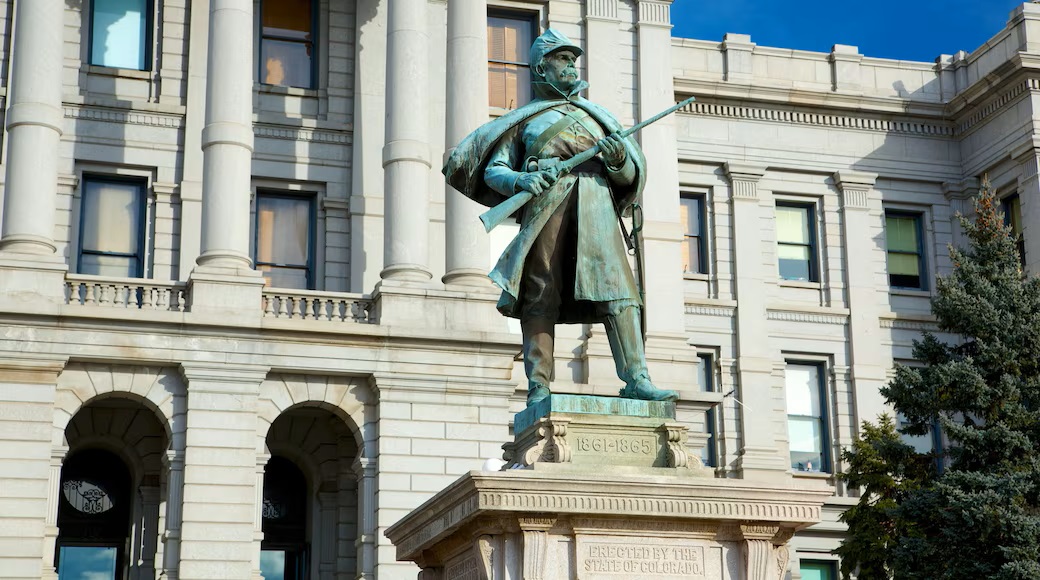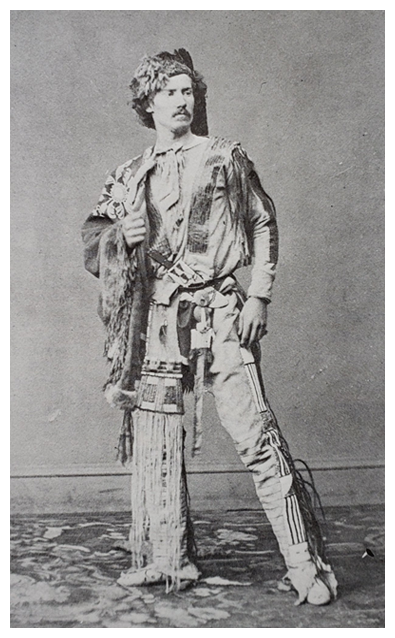
Jack Howland
I’ve been reading a book this week about Jack Howland.
The name may be unfamiliar to you – he is the designer of a Civil War memorial statue which sat on the grounds of the Colorado State Capitol and was recently toppled by an angry mob.
I learned of this book from a friend in our Bible study class who happens to be a great-granddaughter of his.
I thought I should let you know a few things about this artist.
John Dare Howland was born in Zanesville, Ohio on May 7, 1843, son on an Ohio riverboat captain and descendant of those who came to this land on the Mayflower.
At age 10, he began spending his summers as a cabin boy on his father’s boat. His father was intent on making a riverman of him, but young Jack had other plans. At age 14, wearing a coonskin cap and carrying a rifle, powder horn, Bowie knife and 87 cents, he set out towards the western frontier.
 He worked his way west on the river boats to Fort Laramie, where he started as a trader for the American Fur Company.
He worked his way west on the river boats to Fort Laramie, where he started as a trader for the American Fur Company.
He made friends with the Sioux Indians, eating with them, sleeping in their teepees and accompanying the young braves on their hunts.
Howland remained with the Sioux for two years and was not long in adopting their manners and customs. He learned how to stalk prey, to throw a lance, and how to shoot with a bow and arrow.
In 1859, Jack came to Colorado searching for gold, but failed in that adventure.
When the Civil War started, Howland enlisted in the 1st Regiment Cavalry of Colorado Volunteers. During the war and after, Howland served as artist-correspondent for Harpers Weekly and Leslie‘s Magazine.
After the war, he continued his artistic career in Washington, DC and from there, traveled to Paris to study art. He returned to serve on the Indian Peace Commission.
He eventually settled down in Denver and, in 1905, was selected to design a Civil War memorial for the State Capitol. He is considered by many to be Denver’s first resident artist.
Howland’s wanderlust and love of art drove him from the Ohio River Valley to the mountains of Colorado to the capitols of Washington and Paris. And throughout his adventures, he created art. He painted Indians, wildlife, prairie and mining life, the ravages of war and 40 years after its conclusion, designed a monument to those who fought that war.
Jack Howland passed away on September 10, 1914. Per his wishes, his ashes were scattered in the Colorado mountains.
In the book’s final chapter entitled “The Last Trail”, the author ends with this:
“The buffalo have long vanished from the scene but are preserved for posterity in his many paintings of them. Barbed wire fences have divided the plains into plots of ranches and farms. A few deer, antelope, and bear are left to range over the prairies and in the Rocky Mountains where the golden curtain of sunset is unmatched in it’s coloring.
Howland was a picturesque man of the West who lived and painted the vanished frontier for over half a century. He gained immortal fame through his many canvases which are still extant and adorn many walls scattered over the world. His prolific brush brought him honors and fame. His paintings are a triumph to his genius and art, and he should be ranked among the great Western artists.”
The name may be unfamiliar to you – he is the designer of a Civil War memorial statue which sat on the grounds of the Colorado State Capitol and was recently toppled by an angry mob.
I learned of this book from a friend in our Bible study class who happens to be a great-granddaughter of his.
I thought I should let you know a few things about this artist.
John Dare Howland was born in Zanesville, Ohio on May 7, 1843, son on an Ohio riverboat captain and descendant of those who came to this land on the Mayflower.
At age 10, he began spending his summers as a cabin boy on his father’s boat. His father was intent on making a riverman of him, but young Jack had other plans. At age 14, wearing a coonskin cap and carrying a rifle, powder horn, Bowie knife and 87 cents, he set out towards the western frontier.
 He worked his way west on the river boats to Fort Laramie, where he started as a trader for the American Fur Company.
He worked his way west on the river boats to Fort Laramie, where he started as a trader for the American Fur Company.He made friends with the Sioux Indians, eating with them, sleeping in their teepees and accompanying the young braves on their hunts.
Howland remained with the Sioux for two years and was not long in adopting their manners and customs. He learned how to stalk prey, to throw a lance, and how to shoot with a bow and arrow.
In 1859, Jack came to Colorado searching for gold, but failed in that adventure.
When the Civil War started, Howland enlisted in the 1st Regiment Cavalry of Colorado Volunteers. During the war and after, Howland served as artist-correspondent for Harpers Weekly and Leslie‘s Magazine.
After the war, he continued his artistic career in Washington, DC and from there, traveled to Paris to study art. He returned to serve on the Indian Peace Commission.
He eventually settled down in Denver and, in 1905, was selected to design a Civil War memorial for the State Capitol. He is considered by many to be Denver’s first resident artist.
Howland’s wanderlust and love of art drove him from the Ohio River Valley to the mountains of Colorado to the capitols of Washington and Paris. And throughout his adventures, he created art. He painted Indians, wildlife, prairie and mining life, the ravages of war and 40 years after its conclusion, designed a monument to those who fought that war.
Jack Howland passed away on September 10, 1914. Per his wishes, his ashes were scattered in the Colorado mountains.
In the book’s final chapter entitled “The Last Trail”, the author ends with this:
“The buffalo have long vanished from the scene but are preserved for posterity in his many paintings of them. Barbed wire fences have divided the plains into plots of ranches and farms. A few deer, antelope, and bear are left to range over the prairies and in the Rocky Mountains where the golden curtain of sunset is unmatched in it’s coloring.
Howland was a picturesque man of the West who lived and painted the vanished frontier for over half a century. He gained immortal fame through his many canvases which are still extant and adorn many walls scattered over the world. His prolific brush brought him honors and fame. His paintings are a triumph to his genius and art, and he should be ranked among the great Western artists.”